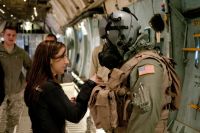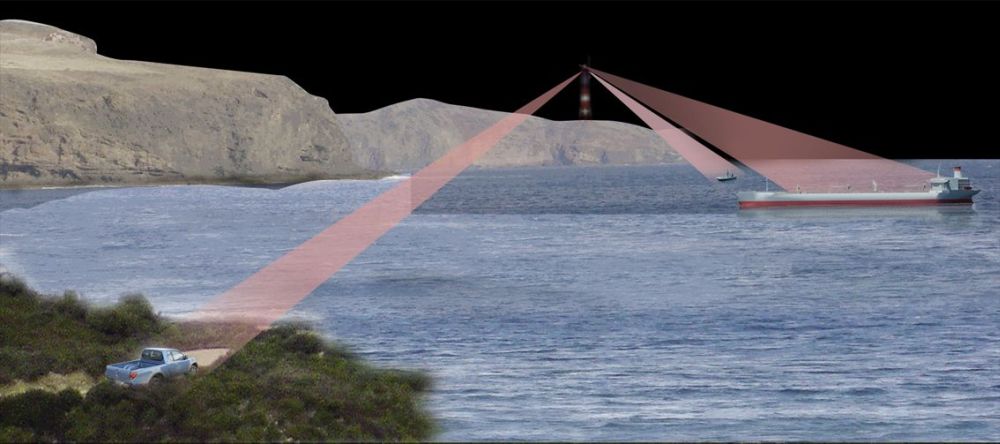MARTINSBURG, W.Va. (AFNS) — Develop one aircrew mask that can be used on over 100 different air frames. That is the challenge for researchers assigned to the Joint Service Aircrew Mask-Fixed Wing Program.
In early December, JSAM-FW researchers visited the 167th Airlift Wing, a West Virginia Air National Guard unit here, to evaluate the JSAM’s ability to integrate to the C‑5 Galaxy aircraft. Nicole Fletcher, an Army chemist and JSAM-FW systems engineer, said the mission was to “nail down configurations so that they can start working on logistics and test plans.”
Kevin O’Neal, a combat developer with the Air Force Air Combat Command, said the team hoped to hammer out a universal communications configuration for the mask and determine which hoses can be used for the breathing system.
The 167th Aircrew Flight Equipment section hosted the JSAM-FW team as it worked with 167th Airlift Squadron aircrew members in each of the flying positions. Pilots, loadmasters and flight engineers donned the mask and accompanying equipment. They then performed various functions of their duty mission. Afterward, each Airman completed a questionnaire, providing feedback to the JSAM-FW team.
Maj. Jeff Musser, a pilot with the 167th Airlift Wing, volunteered to participate in the assessment. He said the mask was definitely better than what aircrews are currently issued.
“It’s less cumbersome,” Musser said. “There’s increased visibility, and it’s easier to breathe through.”
Musser also noted that having a filter canister that can be changed to either side of the mask is a good feature for pilots who may sit in either the right or left seat of the cockpit.
Tech. Sgt. Michael Lindamood, a loadmaster with the unit, also participated in the team’s evaluation and echoed Musser’s sentiments on the mask.
“It’s better than what we have now,” he said. “It’s user-friendly, and as far as assembly, it’s less to carry around. It doesn’t bog you down or get in your way.”
As part of a Department of Defense modernization program to improve the current aircrew eye and respiratory protection, the JSAM-FW project falls under the Joint Services Joint Program Executive Office for Chemical and Biological Defense.
Chief Master Sgt. Danny Effland, the section chief for the 167th Aircrew Flight Equipment section, said the JSAM will potentially replace the AERP. Effland was responsible for coordinating the team’s visit to the unit.
He explained that when the AERP — made up of the mask, blower unit and intercom system — is issued to aircrew before a mission, it adds an additional 45 minutes to the crew day due to the 26 steps needed to preflight the equipment.
Effland said with the M‑53 Aircrew Chemical Biological Mask, all of that is eliminated.
“Time, manpower and money are saved, and there’s probably better protection,” he said.
The M‑53 mask is part of the JSAM system. The M‑53 works in the positive and negative mode.
“Negative meaning on ground, and positive mode meaning we hook a blower up to it,” O’Neal said. The M‑53 also integrates night-vision goggles and laser eye protection.
The development of a joint air crew mask has been 10 years in the making. Initially, researchers were hoping to find one mask to meet the requirements of all aircrew in every branch of the military on all aircraft. The progress was slow due to the challenges of fitting aircrew for more than 125 airframes, Fletcher said.
It was determined that finding a mask to meet all aircrew requirements was unlikely, so the program split into fixed wing and rotary wing aircraft, she added.
There were still many challenges to finding one mask to meet all requirements for fixed wing air crew, but after discovering the M‑53, a ground crew mask manufactured by Avon Protection, the program has catapulted forward, O’Neal said.
Fletcher explained that preliminary testing proved the M‑53 to be feasible for the joint mask criteria. After altitude chamber testing, a few changes were made to the mask, and now it looks like it may provide a cost savings in procurement and sustainment.
Effland said it was an “awesome experience” to have the team come to the unit and conduct evaluations.
“It’s great for the guys in the shop to see the behind the scenes of the equipment we issue and the steps it takes for the equipment to get here,” he said.
Effland added that he might not be around when the JSAM and M‑53 are standard issue for the aircrew, but some of the young Airmen will still be serving the unit. He said it will be great for them to know that they had a part in the process.
Source:
U.S. Department of Defense
Office of the Assistant Secretary of Defense (Public Affairs)

 von
von 

